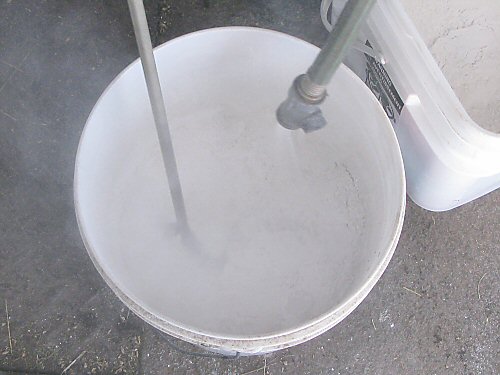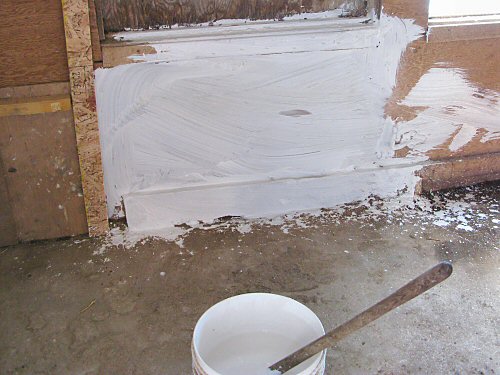
Whitewashed the meat bird half of the Chickenhouse today, using the traditional purist blend of nothing but hydrated lime and water. This is an old school farming standard from Bob, completely new to me.
The lime is a very fine powder that comes in bags. Mixing was easy. A power drill mixing attachment churned it to a thickness a bit lighter than regular paint, and then on it went with big brushes.
The lime is a bit caustic, so wearing a mask when mixing, and gloves and goggles to avoid splatter, is a good idea, although I didn’t this time around (and I did take care not to inhale clouds of lime dust!).
Afterwards (it’s follow Bob’s lead), I did some reading and, not surprisingly, was quite amazed: yet another simple, inexpensive, effective approach that’s been complicated (in this case, into the costly world of high tech paints and sealants).
Classic lime whitewash disinfects, repels insects, and preserves by sealing surfaces and wicking up water. It dries to an opaque white that beautifully reflects light to brighten up dim spaces.

It’s also safe for animals (which, yes, includes us humans, lime can even be used in chicken litter to keep it dry).
There are lots of applications, interior and exterior, for wood and masonry. It’s not as permanent as oil or latex paint, will rub off a bit, and needs to be refreshed every year to keep it in top shape.
It’s also INEXPENSIVE: a 50lb (22.5kg) bag was about $7, and you can mix up at least 15-20 gallons from that, the way we used it. That means you could whitewash an entire small building, inside and out, for maybe $20! For big jobs, a sprayer would make it real easy.
You can tint it, and there are also various recipes that include alum, salt and other additives that may improve adhesion, but the tried-and-true basic is just lime and water.
And you need hydrated lime (calcium hydroxide), NOT dolomitic lime nor calcium carbonate, aka garden lime (both are recommended for raising pH in garden soil). We got ours from the feed store.
I’m not sure how popular this sort of whitewashing is these days, but it’s certainly still used, and a few decades ago, this was a standard type of paint. Anyhow, it looks and sounds great, and we’ll see how the chickens like it!




I have purchased pulverized dolomitic Lime at a Garden Center. Will this type work for interior whitewashing? It looks very tan once wet. Thank you for your post and any help anyone can provide.
Interested in chicks info
I am so excited about whitewashing the inside of my garden shed after reading about all the benefits and seeing pictures. BUT I am so confused about what type of lime to buy. The more I read, the more confused I am because I am getting contradictory information. Hydrated lime, but not garden lime (some garden lime IS hydrated lime). Quicklime, but on Amazon quicklime can be calcium oxide, calcium carbonate, or pickling lime. Slake lime or masonry lime. CAN SOMEONE PLEASE EXPLAIN? AND SEND A LINK? I live in the US so I want to order from here. Thanks so much.
Hydrated lime (calcium hydroxide), is what you want (aka slaked lime). Not ag lime, aka garden lime (crushed limestone; calcium carbonate). Not dolomitic lime (crushed dolomitic limestone; calcium carbonate with magnesium carbonate). Not quicklime (calcium oxide), which can be slaked (turned into hydrated lime) by adding water, an unnecessarily troublesome and possibly hazardous process, when you can easily get hydrated lime in the US. For a very detailed discussion of whitewash: Limewash: Compatible Coverings for Masonry and Stucco.
It is also called Mason’s Lime and is sold at masonry supply stores. Dolomitic lime which is used to adjust the pH of soil won’t work.
A terrific product once you find it but extremely caustic so wear eye protection, it burned off my cornea and I am lucky to still have vision in that eye